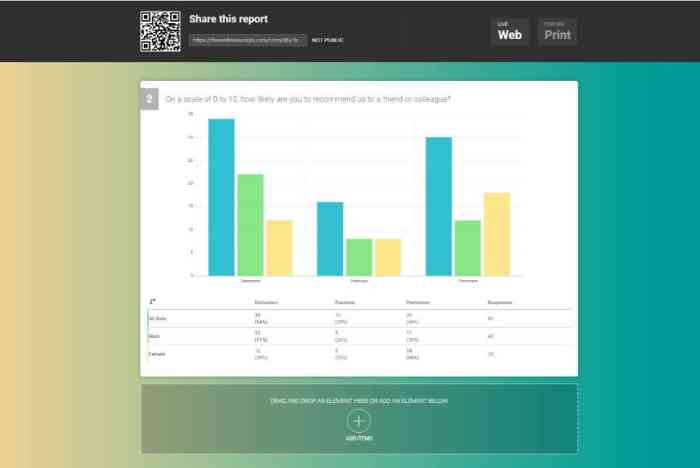Creating Online Surveys dives into the world of data collection with a modern twist, exploring the benefits, design tips, and analysis of online surveys. From industries to personal projects, this guide has you covered.
Introduction to Creating Online Surveys
Online surveys play a crucial role in collecting valuable data for various purposes. They offer a convenient and efficient way to gather insights from a large audience quickly and cost-effectively.
Importance of Online Surveys
Online surveys provide businesses, organizations, and researchers with the opportunity to gather feedback, opinions, and preferences from a wide range of respondents. The data collected through online surveys can be used to make informed decisions, improve products or services, measure customer satisfaction, conduct market research, and more.
- Online surveys allow for easy customization and flexibility in question types, enabling researchers to gather specific information tailored to their needs.
- They offer a higher response rate compared to traditional methods like paper surveys, as they can reach a larger audience through email, social media, and websites.
- Online surveys provide real-time data analysis, allowing researchers to quickly interpret and act on the results.
Online surveys are a powerful tool for collecting data and gaining valuable insights into the thoughts and opinions of your target audience.
Benefits of Using Online Surveys
Industries across various sectors utilize online surveys to gather feedback, conduct market research, and make data-driven decisions. Some common industries that heavily rely on online surveys include:
- Market Research: Companies use online surveys to understand consumer behavior, preferences, and trends to develop effective marketing strategies.
- Education: Schools and educational institutions use online surveys to gather feedback from students, parents, and faculty to improve the quality of education.
- Healthcare: Healthcare providers use online surveys to collect patient feedback, measure satisfaction levels, and improve the quality of care.
- Non-profit Organizations: Non-profits use online surveys to engage with donors, volunteers, and beneficiaries to assess the impact of their programs and services.
Designing Effective Online Surveys

Creating clear and concise survey questions is crucial for gathering accurate and valuable data. Avoid using jargon or complex language that may confuse respondents. Keep the questions simple and to the point to ensure clarity.Survey logic and branching are essential for providing a personalized experience to respondents. By tailoring the survey flow based on previous answers, you can make the survey more engaging and relevant to each participant.
Using Different Question Types
- Multiple-choice questions: Offer a list of options for respondents to choose from. This type is great for collecting quantitative data and comparing responses.
- Open-ended questions: Allow respondents to provide detailed answers in their own words. These questions are useful for gathering qualitative data and insights.
- Rating scales: Use scales like Likert scales to measure attitudes or opinions. This type of question provides a range of choices for respondents to rate their agreement or satisfaction levels.
Selecting the Right Online Survey Tool

When it comes to creating online surveys, choosing the right survey tool is crucial for gathering accurate and valuable data. There are various popular online survey platforms available, each offering unique features and pricing plans. Let’s dive into the key factors to consider when selecting the best online survey tool for your needs.
Compare and Contrast Popular Online Survey Platforms
- Surveymonkey: Known for its user-friendly interface and robust features, Surveymonkey offers a variety of survey templates and customization options. However, it can be quite pricey for advanced features.
- Google Forms: A free option with seamless integration with Google Workspace, Google Forms is perfect for basic surveys. It may lack advanced features compared to other platforms.
- Typeform: Typeform stands out for its interactive and engaging survey designs. It’s great for creating visually appealing surveys, but the free version has limitations.
Key Features to Consider When Choosing a Survey Tool
- Survey Customization: Look for a tool that allows you to create surveys that match your brand and style.
- Response Analysis: Ensure the tool provides detailed analytics and reporting to help you interpret survey results effectively.
- Integration Options: Consider whether the survey tool integrates with other software or platforms you use for seamless data collection and analysis.
Insights on Pricing Plans and Scalability Options, Creating Online Surveys
- Free Plans: Some survey tools offer basic features for free, making them ideal for small-scale surveys or personal use.
- Paid Plans: Paid plans often unlock advanced features such as advanced analytics, more customization options, and increased response limits.
- Scalability: Choose a survey tool that can scale with your needs as your survey projects grow in size and complexity.
Distributing and Promoting Online Surveys
To ensure the success of your online survey, it is crucial to effectively distribute and promote it to reach a wider audience. Utilizing various methods and strategies can help increase response rates and gather valuable data.
Utilizing Email for Survey Distribution
- Send personalized emails to targeted recipients.
- Include a clear and concise survey invitation in the email body.
- Avoid spamming and ensure emails are relevant to the recipients.
- Follow up with reminder emails to non-respondents.
Leveraging Social Media Platforms
- Share survey links on popular social media platforms like Facebook, Twitter, and Instagram.
- Create engaging posts with visuals to attract attention.
- Utilize relevant hashtags to increase visibility.
- Encourage followers to share the survey with their networks.
Utilizing Websites for Survey Promotion
- Embed survey links on your website or blog.
- Create pop-up notifications or banners to promote the survey.
- Incorporate the survey into your website’s navigation menu.
- Offer incentives like discounts or giveaways for completing the survey.
Increasing Survey Response Rates
- Offer incentives such as gift cards, discounts, or entries into a prize draw.
- Create engaging and interactive survey questions to maintain respondent interest.
- Keep surveys short and concise to avoid respondent fatigue.
- Personalize survey invitations to make respondents feel valued.
Importance of Promoting Surveys
- Reach a larger and more diverse audience for valuable data collection.
- Increase response rates by engaging with respondents through various channels.
- Enhance the visibility of your survey to gather meaningful insights.
- Maximize the impact of your survey by promoting it through multiple platforms.
Analyzing and Interpreting Survey Results: Creating Online Surveys
Analyzing and interpreting survey results is a crucial step in deriving valuable insights from the data collected. By using different methods for analysis and interpretation, you can uncover trends, patterns, and key findings that can inform decision-making processes.
Quantitative Analysis
- Quantitative analysis involves numerical data and statistical techniques to identify patterns and correlations within the survey responses.
- Common methods include calculating averages, percentages, and conducting regression analysis to understand relationships between variables.
- Tools like Excel, SPSS, or other statistical software can be utilized for in-depth quantitative analysis.
Qualitative Analysis
- Qualitative analysis focuses on the textual responses and open-ended questions in the survey to gain insights into participants’ opinions, attitudes, and perceptions.
- Methods include thematic analysis, content analysis, and sentiment analysis to categorize and interpret qualitative data.
- Manually reviewing responses or using text analysis tools can aid in qualitative analysis.
Interpreting Survey Results
- When interpreting survey results, look for patterns, trends, and significant differences in responses across different demographic groups or survey questions.
- Compare results to benchmarks or previous surveys to assess changes over time or against industry standards.
- Consider the context of the survey questions and responses to draw meaningful conclusions and actionable insights.
Presenting Survey Findings Effectively
- Use visualizations such as charts, graphs, and infographics to present survey findings in a clear and engaging manner.
- Summarize key findings and insights in a concise and structured format to highlight the most important takeaways from the survey.
- Provide context and explanations for the data presented to help stakeholders understand the implications of the survey results.